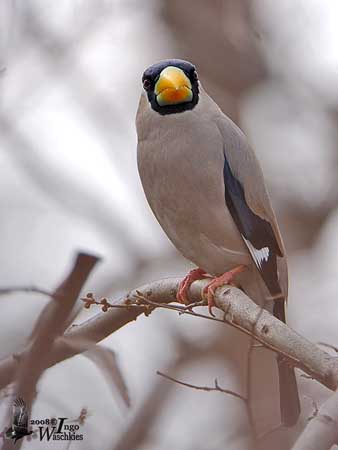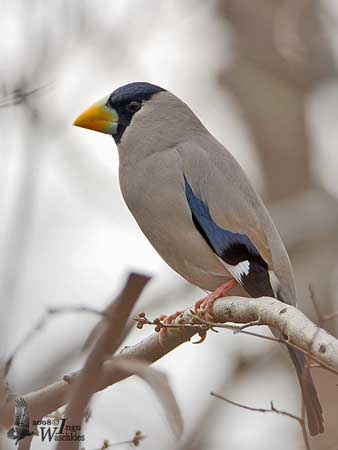
Fr: Gros-bec masqué
All : Maskenkernbeisser
Esp : Pepitero Enmascarado
Ital: Frosone mascherato
Nd: Maskerdikbek
Sd: Större maskstenknäck
Photographer:
Ingo Waschkies
Bird Photography
Text by Nicole Bouglouan
Sources:
HANDBOOK OF THE BIRDS OF THE WORLD Vol 15 by Josep del Hoyo-Andrew Elliot-David Christie - Lynx Edicions – ISBN: 9788496553682
A Field Guide to the Birds of South-East Asia by Craig Robson. New Holland Publishers. ISBN: 9781780090498
Ottaviani, M. (2008) Monographie des Fringilles (fringillinés – carduélinés) – Histoire Naturelle et photographies, Volume 1. Editions Prin, Ingré, France, 488 p.
Ottaviani, M. (2011a). Monographie des Fringilles (carduélinés) – Histoire Naturelle et photographies, volume 2. Editions Prin, Ingré, France, 286 p.
Ottaviani, M. (2011b). Monographie des Fringilles (carduélinés) – Histoire Naturelle et photographies, volume 3. Editions Prin, Ingré, France, 320 p.
BirdLife International (BirdLife International
Wikipedia, the free encyclopaedia
Japanese Grosbeak
Eophona personata
Passeriforme Order – Fringillidae Family
BIOMETRICS:
Length: 18-23 cm
Weight: M: 65-100 g
DESCRIPTION:
The Japanese Grosbeak is a large finch native to East Asia.
The adult male of nominate race has black face and crown, from forehead to upper nape, crown sides, to cheeks and chin. This mask is narrowly edged whitish-grey. In fresh plumage, these black feathers are glossy blue.
The body plumage is pale grey, sometimes washed buffish mainly on the upperparts. The uppertail-coverts are duller grey, whereas the long, forked tail is bluish-black, with black outermost rectrices.
On the black or bluish-black upperwing, secondaries are edged glossy blue-black. There is a triangular white patch on primaries on closed wings, forming a conspicuous white wingbar well visible in flight. Tertials are buff-brown with paler or greyer fringes.
The underparts are pale grey with pale tawny flanks and white belly and undertail-coverts.
The large, conical bill is bright yellow with pale base. The eyes are dark brown. Legs and feet are pinkish.

The female resembles male with duller wings and narrower glossy blue edges of secondaries.
The juvenile is duller grey on body. The black mask is restricted to lower forehead, base of bill and lores. The upperparts and the rest of the head are buff-brown with greyish tinge. The scapulars can be weakly streaked blackish. The white wing patch is smaller.
There are two subspecies:
E.p. personata (here described and displayed) breeds in N and C japan and winters southwards to S Japan.
E.p. magnirostris breeds in Russian Far East, Sakhalin Island, and NE China. This race is larger than nominate, with slightly larger bill too. Its plumage is paler with smaller white wing patch.
VOICE: SOUNDS BY XENO-CANTO
The Japanese Grosbeak gives short, hard calls “tak, tak” in flight. We can also hear high-pitched “kik” while the birds are foraging in trees or flying.
The song is a short series of fluty whistled notes “tsuki-hi-hoshi” rising and falling.
HABITAT:
The Japanese Grosbeak occurs mainly in lowlands where it frequents open mixed and deciduous forests and woodlands, edges of cultivated areas, well-wooded hills, parks and gardens. It can be seen up to 800 metres of elevation.
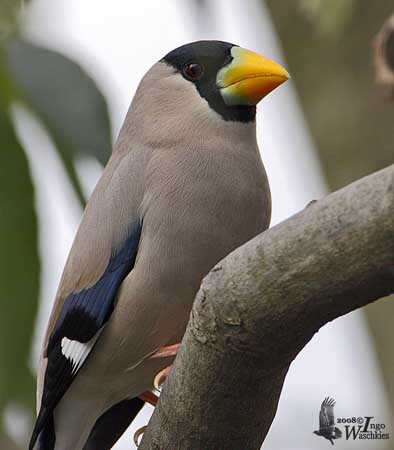
RANGE:
See above in “subspecies”
BEHAVIOUR:
The Japanese Grosbeak feeds on numerous seeds such as those of cedar, pine and birch. It also takes berries. During summer, it feeds on insects including Coleopteran and caterpillars.
This species forages in trees where it remains within vegetation and foliage in canopy. It may sometimes forage at lower level in bushes.
They usually occur in pairs or small flocks. They are often heard first, before to be seen among the vegetation.
The Japanese Grosbeak uses its strong bill and the force of its jaws to get the seeds from the hardest kernels. It does not need to use the feet to assist in this feeding process. Seeds are eaten while pulp and skin are discarded. It feeds on both ripe and unripe seeds, although it prefers the seeds of ripe fruits.
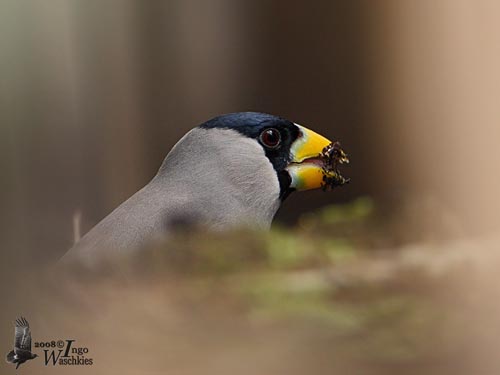
During the breeding season, they defend a small area around the nest, but they spend little time on territorial defence or advertising behaviour.
However, communication and contacts between mates are frequent.
The male probably performs “mate-guarding” by following the female wherever she goes. She incubates and broods the chicks, but the male forages and feeds her on nest by regurgitation.
Weak aggressive behaviour by male towards one another starts while they are in winter flocks. Chasing and increasing singing are reported. Some postures towards females are performed too, in order to approach them.
Some ritualized aggressions towards the female and chases occur, and the male also regurgitates seeds for her. Then, both mates select a nest-site and defend it. Some flight displays may occur prior to copulation.
This breeding behaviour is that of numerous Fringillidae species, but that of the Japanese Grosbeak is currently little known.
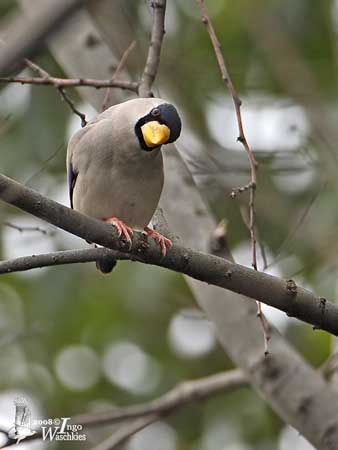
FLIGHT:
The Japanese Grosbeak performs undulating flight, more pronounced over long distances.
REPRODUCTION:
The breeding season takes place between May and July.
The Japanese Grosbeak’s nest is a large, deep cup placed between two and six metres above the ground in tree. It is made with sticks and twigs, grass blades and stems. The inner cup is lined with softer grasses.
The female lays 3-4 pale blue eggs with fine blackish markings. She incubates while the male feeds her on nest by regurgitation. Chicks are fed by both parents.
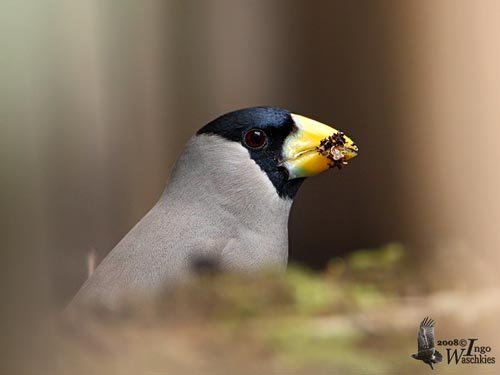
DIET:
The Japanese Grosbeak feeds primarily on seeds from cedar, pine and birch. It also takes berries. During summer, Coleopteran and caterpillars are caught too.
PROTECTION / THREATS / STATUS:
The Japanese Grosbeak is common to locally common in its range, and may occasionally be abundant.
In spite of heavy trapping for cagebird trade in China, this species is not currently threatened.
